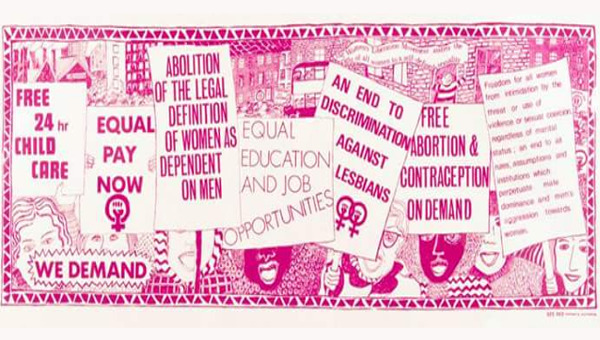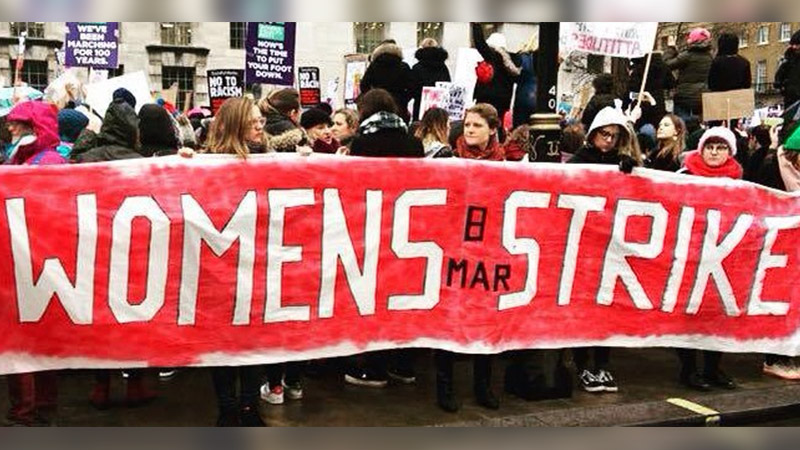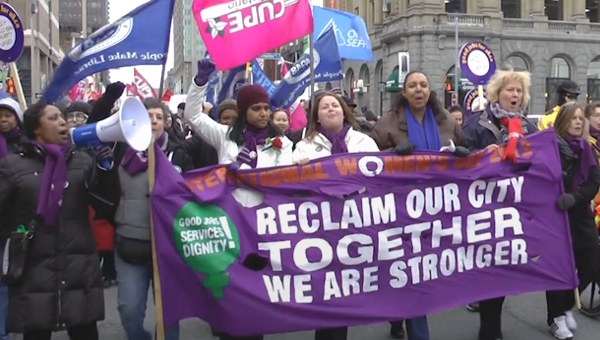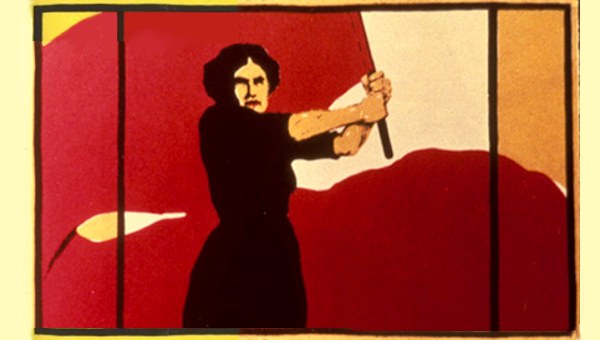IWD: Looking Back and Looking Ahead
Looking Back on the Women’s Liberation Movement
Judith Green
In a sexist society, sexism imbues every facet of life. The Women’s Liberation Movement of the 1960s involved a huge truth-telling by women about the realities of their lives, to each other and to the world, in an effort to change themselves and the world. Out of that great cataloguing of the injustices against us, women in the UK developed seven demands at a series of conferences taking place from 1970 to 1978.

The first of those gatherings opened exactly forty-eight years ago today (27 February – 1 March 1970), when women in Oxford expanded an original idea for a conference on Women’s History into an event focused on the urgent contemporary concerns of women.
300 women were expected, but 600 arrived, and together addressed issues out of which the first four demands of the Women’s Liberation Movement National Conferences were developed.
These were:
- Equal pay
- Equal educational and job opportunities
- Free contraception and abortion on demand
- Free 24-hour nurseries
Priorities
While embraced by the whole Women’s Liberation Movement, and agreed at the Skegness conference in 1971, the emphasis of the first four demands reflect the priorities of the Women’s National Coordinating Committee elected at that first conference and dominated by left groups.
Taken together they envisage women liberated from the burdens of motherhood and by the removal of barriers to full economic participation. Such liberated women could be the equal of men as workers in struggle, men who – as a group – were not addressed by these demands. Instead, the demands were addressed to legislators, employers, health services and the public sector.
They followed the struggle for the passing of the Abortion Act (1967) and women workers strike for equal pay at the Ford plant in Dagenham (1968) and were part of the effort to achieve Equality legislation in the form of the Equal Pay Act (1970) and Sex Discrimination Act (1975).
The Women’s National Coordinating Committee was disbanded following the Skegness conference.
Two further demands were added at the Edinburgh Conference in 1974.
- Legal and financial independence for all women
- The right to a self-defined sexuality. An end to discrimination against lesbians
While these demands do not name men directly, they are more ‘present’ than in the first four.
Legal and financial independence from men, and a right to a self rather than an ‘other’ (male) defined sexuality are at least implied.
The seventh and final demand was added at the Birmingham Conference in 1978.
- Freedom for all women from intimidation by the threat or use of violence or sexual coercion regardless of marital status; and an end to the laws, assumptions and institutions which perpetuate male dominance and aggression to women.
Whereas the first four demands had been specific, and with the emphasis on economic equality and reproductive rights, the seventh demand encompassed – in the “laws, assumption and institutions which perpetuate male dominance” – the entirety of the social system of male supremacy or patriarchy.
Men’s dominance over women, and the role of violence in maintaining it, were named directly for the first time, but not without some controversy.
Socialist feminists and non-aligned supporters won the day in striking down the proposed preamble stating that “Men’s violence against women is an expression of male supremacy and political control of women.”
Socialists and Radicals
The Women’s Liberation Movement Conferences have sometimes been described as occasions of painful schism and rancour between two wings of committed feminists: socialists and radicals.
Each side made harsh criticisms of the other. The shadow of these disagreements has been long, with blame often apportioned and a litany of bad behaviour catalogued. I have no intention of doing that in this short article.
As a socialist feminist in the twenty-first century looking back, I am as frustrated with the inadequacy of my tradition to theorise and tackle male violence as my radical sisters were in the 1970s.
Not a single one of the Women’s Liberation Movement Demands has been properly fulfilled – be that economic or reproductive rights, sexual liberation for women or ending endemic male violence against women and girls.
Notable absences from the demands are to a address the unpaid labour of women in the home, sexist stereotypes and socialisation, or the field of representation – both political and in media imagery. There is now recognition amongst feminists of the socialist tradition that inequality between women and men is both a cause and consequence of male violence and that naming male violence is vital to ending it.
#NotAllMen is understood as the derailment from talking about women’s experience that it always was.
While there is a feminism that believes being inclusive is more important than protecting women’s rights, the need for a Women’s Liberation Movement fit for purpose has never been more urgent.
The need to rebuild a women-centred movement is recognised by both socialist and radical feminists, who have much in common.
It’s been a long journey since the heady days of the second wave Women’s Liberation Movement Conferences. What no one involved in them could have anticipated was the need to spell out that sex exists and has social significance on account of sexism.
We might propose a new demand: perhaps numbered zero, our bottom-line ‘Recognise sex and sexism’. •
This article first published by Socialist Feminist.network.
Our Feminism Must be Anti-Capitalist
Celeste Murillo and Andrea D’Atri
“The socialist who is not a feminist lacks breadth. The feminist who is not a socialist lacks strategy.” — Louise Kneeland
On March 8, 2017 women around the world marched through the largest metropolitan centers. The call for a global strike revived International Women’s Day – long relegated to a largely symbolic, celebratory formality for a small group of feminists and leftists. This year, millions claimed the day as their own. They organized actions in workplaces and schools and attended massive demonstrations. Protests large and small took place in 50 countries around the world – from the U.S. to Nigeria to Indonesia.
Madrid’s Gran Via was entirely shut down hours before the marches began, and almost all of the capital cities in Europe participated in these international mobilizations. In Montevideo, Uruguay, thousands took to the streets and there was a six-hour work stoppage called for by the trade union confederation PIT-CNT.
In the US, after the record-breaking women’s marches on January 21 that mobilized an estimated three million people across the country, there was an upsurge of protests on March 8, reviving a tradition that had long been lost in the heart of imperialism.
Even without having read the declarations of feminist organizations, trade unions, and political parties, women around the world expressed their rage against sexist violence, the precarious labor conditions that condemn them to misery, the irrational inequality that keeps women subordinate, and the constant fear that molds women’s existence.
In Argentina, this rage fed into large-scale participation in strikes – far greater participation than the union bureaucracy had intended. At the PepsiCo factory, work stoppages began at 5:00 am, based on a vote by a workers’ assembly called for by the shop council, which stands in opposition to the current union leadership. At the Buenos Aires airport, LATAM airlines workers stopped check-in services, once again bolstered by assemblies organized by the opposition to the union leadership. omen from the socialist women’s organization Pan y Rosas (Bread and Roses) formed part of the oppositional caucasus in both of these work stoppages, and along with other male and female coworkers, were integral in the fight for a strike on March 8. In addition, there were countless partial work stoppages and protests in hospitals. Teachers also played an important role, forcing several unions to engage in strikes in the midst of a struggle between the teachers and the national and state governments.
Equality in Law is Not Equality in Life
What is the explanation for the renewal of mass demonstrations and protests on March 8? There are many who criticized the marches, saying women have already achieved equality. The reality is that, with the capitalist crisis underway, there are deepening contradictions between the rights that have been won (at least in the imperialist countries and some semi-colonies like Uruguay, which has legalized abortion and same-sex marriage) and the material conditions of the majority of women, as austerity measures and cuts affect large sectors of the population. These economic realities are compounded by interminable sexist violence, in which the state and its institutions are complicit.
However, the expansion of rights has opened the eyes of millions of women and elevated their aspirations for a better life. The harsh realities that hold women back have kindled a sense of rage. After decades of neoliberalism, the economic crisis and all of its social consequences demonstrate more and more clearly that “equality in law is not equality in life.”
These enormous March 8 demonstrations didn’t appear overnight. They were preceded by recent actions around the world, including the massive Ni Una Menos (Not One Less) mobilizations against femicide in Argentina demanding that the state allocate money and take other measures to prevent femicides; the strikes in Iceland and France against the gender pay gap; the protest under torrential rain where hundreds of thousands of women stopped the further criminalization of abortion in Poland; and the massive women’s protests against Trump in the United States.
The widespread support that these protests generate among ordinary citizens is evidence that they express not only the demand for women’s rights but also the discontent of millions of workers and students with austerity, cuts, and precarious working conditions caused by the capitalist class and the governments that forced workers to pay for the crisis in order to maintain their profits. This unity between workers and students is the seed of an alliance that will be essential for defeating capitalist patriarchy.
Nothing is Achieved Without Struggle
This new wave of women’s mobilizations is international and more radical in character, breaking with decades of liberal feminist hegemony. In previous years, it became common sense to think of individual free choice as the horizon of emancipation, without challenging capitalist democracies – without questioning the fact that the rights that were won were only available to a small number of women.
According to this de-politicized and de-politicizing framework, women’s emancipation is simply a question of gradually gaining rights within the existing political regime. Once these rights have been written into law, each woman will individually be responsible for the life she “chooses” to live.
The flaw in this reformist logic is the separation between the fight for democratic rights and the struggle against the social and economic system. By fighting for rights within bourgeois democracy without questioning the capitalist structure that maintains and profits from sexism, reformist feminism implicitly or explicitly approves of the system that signifies, legitimizes and reproduces women’s subordination. This “feminism” does not take into account that these rights are inscribed in a limited, circumstantial and temporal way in the social system. It does not take into account that many of these rights were won in a moment when capitalism in imperialist countries was not in crisis. What the capitalist governments give with one hand, when there is prosperity, they take with the other when there is a crisis.
What gives women’s demands a political character is not lobbying congress, which is a path to co-optation for many sectors of the movement. Rather, their political character comes from uncovering the intrinsic relation between basic rights that are still denied to us (like the right to not be murdered for being women) and the social system that is based on exploitation by a parasitic class of capitalists.
The liberal discourse transformed feminism, like other social movements of the oppressed, into something so harmless that it could be easily appropriated by the right. This liberal feminism stripped the women’s movement of deeper social criticism and opened the doors to right-wing women. The fact that Ivanka Trump can be presented as a representative of “conservative feminism” shows what a quagmire liberal feminism is trapped in. Sectors of the ruling classes do not have any problem arguing that women, ethnic minorities, and LGBT people should have positions of power in capitalist society. This is how Hillary Clinton presented herself in the elections, the clearest example of imperialist or neoliberal feminism.
But Clinton failed to convince enough women to vote for her in order to break the glass ceiling and be an effective alternative to the Republican candidate, who epitomized modern misogyny. Her corporate feminism fell flat in the face of the problems affecting millions of wage laborers, unemployed workers, Black people, and immigrants.
Today, the Democratic Party hopes to use the reemergence of the women’s movement throughout the world to rebuild itself after the defeat at the hands of the right. It is no coincidence that many of the women who organized the International Women’s Strike in the US warned of the danger of the Democratic Party attempting to capitalize on this enormous movement. Democrats hope to rebuild themselves after their enormous electoral defeat and at the same time are attempting to control the most radical aspects of the women’s movement.
Neoliberal Feminism in Crisis
The USA, as the most important imperialist power, exported liberal feminism to the rest of the globe by imposing a neoliberal world order and corresponding policies towards women in health, education and social welfare using the IMF and the World Bank. This means that in many semi-colonies, these international organisms demanded that countries create gender and sexuality ministries. They even promoted laws to end sexist violence.
This allowed the capitalist state to wash its hands of responsibility for the precarious conditions that most women face. One of the most emblematic examples is in Mexico. Although many laws to prevent sexist violence have been passed, the state continues to be complicit in violence against women, especially workers on the border and Central American immigrants making their way to the US. The United States also disseminated liberal feminist ideology through global non-profits and the export of American academic works in colleges and universities.
Ella Mahony of Jacobin explains:
“It’s become axiomatic in left feminist spaces that there’s a ‘neoliberal’ feminism against which all new forms of feminism must develop. What’s less often articulated is the political character and origins of this corporate feminism. The key catalyst for neoliberal feminism’s rise was the slow asphyxiation of left political alternatives from the 1980s onwards.”
Liberal feminism began to show its weakness in its inability to combat Trump. As we saw in the recent mobilizations of women around the world who contest the myth that we have already achieved equality, as well as in the discussions brought about by Clinton’s loss, neoliberal feminism is being increasingly questioned.
In this sense, the call to build a “Feminism of the 99%” is symptomatic of a changing consciousness that sees the connection between capitalism and patriarchy as the source of many of the problems affecting the majority of women.
The Fight Against Patriarchy Must be Anti-Capitalist
The urge to revive an alliance between the women’s movement and the working class in a country like the US speaks to the possibilities of strengthening an anti-capitalist wing inside the new women’s movement. Similarly, in Argentina, Chile and other countries, the language of anti-capitalism is heard at the meetings of the women’s movement, in their manifestos, and in their mobilizations.
For socialist revolutionaries, the discussion of anti-capitalism opens the doors to a fruitful debate about what strategy and political program should be implemented against patriarchal capitalism. It forces us to think of the alliances we must build to fight for our own emancipation and how we could try to mobilize the working class to take up these demands.
Imagining an anti-capitalist feminism forces us to consider the question of the political subject: without working women, who make up half of the class that is the immense majority of society, there is no future. We fight for a movement of the working class – a movement of the majority, which is antagonistic to the rights of the few capitalists who control our lives. Furthermore, if it is not the working class (both women and men) who fly the banners of emancipation of the most oppressed sectors, then anti-capitalism becomes mere wishful thinking.
This alliance between the working class and women fighting for their rights goes back to the 19th and the beginning of the 20th century, when women were able to win the right to vote and to fight against imperialist wars. The Bolsheviks were able to achieve hitherto unimaginable rights for women by bringing the working class to power. Many of the rights that existed in the USSR in the early 20th century have not yet been won in many capitalist countries.
Since then, this alliance between the working class and women has been perversely annihilated by the ruling classes, by the betrayal of union leaders who immerse the working class in pro-business unionism, and by the co-optation of social movements into the state and their de-politicized fragmentation in nonprofits.
Rebuilding the historic alliance between the working class and the women’s movement is a central task in the rebuilding of a truly anti-capitalist feminism. Only when there is a real stoppage of the production and circulation of goods, of the service sector and of communications, can the more precarious and marginalized people – the housewives being hidden away in individual homes, the women in prostitution, and all of those who are worthless to this ignominious system – make their voices echo in the silence. This alliance is not a given. We must build it.
Building this alliance does not mean overlooking sexism within the working class. Some sectors of the left refuse to confront workers’ prejudices – ideologies fomented by the ruling classes using the institutions under their control, such as the media and schools. These sectors also refuse to put themselves on the front lines of fighting for the most basic democratic rights, arguing that the problem of women’s oppression is only an expression of capitalist exploitation. At the same time, this kind of class reductionism absolves the most conscious members of the working class and even their own militants from responsibility for the reproduction of sexism. When female workers take the front lines of the struggle, like the women at PepsiCo and LATAM, this creates better conditions to both fight against sexism within the working class, but also to fight against the sexism of the bosses. The struggle against class reductionism cannot take the socialist women’s movement to the opposite extreme, taking up individualistic notions of sexism that equate verbal harassment on the street with state sponsored terrorism against women.
The massive mobilization of women around the world gives a new relevance to the debate about the course that the women’s movement should take in order to avoid ending up like the women’s movement of the 70’s. In a contradictory manner, the movement brought about partial triumphs and the expansion of rights. On the other hand, the movement was domesticated and the idea of a radical transformation of the capitalist system was buried. The current movement puts this debate on the table: Is the ultimate goal going to be occasional resistance to right-wing attacks, or are we going to finally build a strategy to win?
The international women’s organization Pan y Rosas (Bread and Roses), of which the authors of this piece are members exists in Argentina, Brazil, Bolivia, Chile, Uruguay, México, Venezuela, the Spanish State, France, and Germany. The organization actively intervenes in and builds this new women’s movement in workplaces, schools and universities with a socialist perspective. We fight for the women’s movement to build roots in the working class and give examples of the revolutionary potential of this alliance.
Our ideas, program and strategy are based on the accumulated lessons learned from previous generations of revolutionary Marxists. We believe in a feminism that seeks to be a political movement of the masses, where the struggle for democratic rights and liberties is connected to a denunciation of this regime of exploitation and misery for the majority. Only a movement that seeks to defeat this system can be truly emancipatory. •

This article first published by Left Voice.





